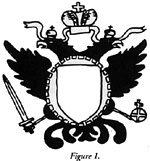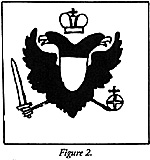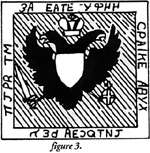RUSSIAN ARMY
The Russians fought the war wearing a very simple and practical uniform. Reflecting the old Russian peasant style, a soldier wore a loose fitting, dark green tunic called a mundir. In the black and white photographs of the period, the dark green color of the mundir appears black. It was gathered at the waist by a belt. Dark green trousers were worn year round, stuffed into knee high black leather boots. A dark green furashka, a type of forage cap, was worn daily and replaced by the shapka, a low crowned fur hat, for parades (though photographs show that the shapka was worn during the war in Manchuria by many units). In the summer, the mundir was replaced by the gimnasterka, a white linen blouse. The dark green furashka cap was either replaced by a white one or fitted with a white cover. The sources are unclear on this point. All equipment was black leather, and an earth gray shinel (greatcoat) was carried rolled over the left shoulder when not worn.
Distinctive colors were worn to identify the wearer's brigade and regiment. The brigade color was worn on the mundir pogoni (shoulder boards); red for the first brigade, blue for the second brigade in each division. Artillery and engineers wore red pogoni, while rifles wore raspberry. The regiment was identified by the color of the mundir collar patches and the furashka cap band, with the first regiment assigned red, the second-blue, the third-white, and the fourth-dark green. It is unclear if these markings were used on the gimnasterka or the white furashka.
Photographs indicate that patches and cap bands were not used on the gimnasterka, only the pogoni. As the East Siberians lacked a division organization prior to the war, and the Siberians were raised during the war, I assume that their uniforms also lacked the color markings. The photographs support this conclusion, showing the Siberian troops with white collars and cap bands. My best guess is that they might have worn wore yellow pogoni.
The artillery and engineers were dressed as the infantry. Musicians
wore the same uniform as the infantry with the addition of swallow-nest
wings on the sleeves at the shoulder seams. [12] These were identical to the ones worn during the Napoleonic Wars. Trim was white with the same dark
green background as the mundir. Swallow-nest wings weren't worn on the white gimnasterka.
The dragoons wore the same uniform as the infantry, except the trousers
were blue. Each dragoon regiment had a distinctive collar and cuff colors
combination, but I do not know the scheme for the three regiments in Manchuria.
Equipment was black leather, with the ammunition pouches worn over the
shoulder instead of at the waist. The Cossacks, except the Kuban and Terek
tribes, wore a uniform similar to the dragoons, but with a wide variety
of colors. The headdress was normally a tall kolpak (fur cap), but the
furashka was also worn.
The Terek and Kuban Cossacks wore Caucasian dress. This is the traditional
dress most Americans identify with the Cossacks. The cherkeska was the
collarless kaftan (coat) with the cartridge loops on the chest. The beshmet
was the shirt with a stand-up collar that was worn under the cherkeska.
The following are the uniform colors for these tribes (cherkeska; pogoni,
piping, crown of kolpak; beshmet):Kuban gray brown, red, red; Terek gray
brown, light blue, light blue.
Before and during the war, the Cossacks increasingly wore the standard
cavalry uniform. The white gimnasterka would be worn with their colored
trousers, kolpak and pogoni. Cossack also had black leather equipment that
was similar to the dragoon regiments. Rank for all branches was indicated
on the pogoni.
Officers wore pogoni with gold stripes running lengthwise.
Company grade officers wore two gold stripes, field officers three stripes.
The background color of the pogoni would show through as a narrow stripe
separating the gold stripes. The background colors were the branch colors
for all but the infantry; the infantry wore the brigade color on the pogoni.
The gold lace on generals' pogoni had a zigzag pattern with red edging
around the pogoni.
Stars indicated the rank within the grade. Ensign-one
star; 2nd lieutenant, major, and major general-two stars; lieutenant, lieutenant
colonel, and lieutenant general-three stars; captain, colonel, and full
general didn't have stars on the pogoni. Enlisted ranks wore white stripes
width wise on the pogoni; One stripe-private, two-corporal, three-sergeant.
Sergeant majors wore a broad gold band instead of the white stripes. Specialty
insignias were worn on the pogoni for units other than infantry and cavalry,
those units wore regimental numbers.
The design seems to be a large Russian double-headed eagle (figure
1). I do not know the color scheme or the details of the badges or crests
on the eagle. A guide to painting could be the Austrian eagle on the cover
of the Osprey Men-at-Arms Flags of the Napoleonic Wars by Terence Wise,
as the Austrian eagle is almost identical to the details I can see in the
pictures of Russian flags.
I do have several photographs of Russian cavalry standards. These appear
to be similar to the Napoleonic period flags with the eagle shown above.
Both the dragoons and Cossacks carried standards, but as the supporting
photographs are black and white, making any color information a guess.
Russo-Japanese War
UNITS
COATS & TROUSERS
PIPING & KOLPACK CROWN
POGONI
Don blue red blue Orenburg green light blue light blue Ural blue carmine carmine Astrakan blue yellow yellow Transbaikal green yellow yellow Ussuri green yellow yellow Siberia green red red Amur green yellow green Semiretschensk green carmine carmine Russian Flags
 Russian flags present a similar problem. Bottom line is that I lack
any data on the exact appearance of Russia flags during the war. From my
readings, I am not sure if the Russians used the inspection system or a
standard flag for their regimental standards. However, I have a picture
of the 55th Infantry regiment carrying only one flag. [16] The flag is hanging from its staff and is not totally clear, but the details that can be seen
match the drawing of a Russian flag in Unger's book [17] , and a drawing from WW II. [18]
Russian flags present a similar problem. Bottom line is that I lack
any data on the exact appearance of Russia flags during the war. From my
readings, I am not sure if the Russians used the inspection system or a
standard flag for their regimental standards. However, I have a picture
of the 55th Infantry regiment carrying only one flag. [16] The flag is hanging from its staff and is not totally clear, but the details that can be seen
match the drawing of a Russian flag in Unger's book [17] , and a drawing from WW II. [18]
 The two drawings have the eagle set on a white background (figure 2), while the picture of the 55th Regiment is on a colored background with a white border containing an inscription (figure 3).
The two drawings have the eagle set on a white background (figure 2), while the picture of the 55th Regiment is on a colored background with a white border containing an inscription (figure 3).
 My guess is that the standard of the 55th is a color of St. George. The staff
of the 55th appears to be 9-10 feet long, with a pointed finial. The flag
itself seems to be 4 1/2 x 5 feet in size. Given Russian tradition, the
final could have been either the double headed Russian eagle or the Cross
of St. George, both in pierced design. As you can see, my information on
Russian flags is incomplete, so I can use any available help on the subject.
My guess is that the standard of the 55th is a color of St. George. The staff
of the 55th appears to be 9-10 feet long, with a pointed finial. The flag
itself seems to be 4 1/2 x 5 feet in size. Given Russian tradition, the
final could have been either the double headed Russian eagle or the Cross
of St. George, both in pierced design. As you can see, my information on
Russian flags is incomplete, so I can use any available help on the subject.
Historical Analysis
The War at a Glance (Chronology)
Books and Other Research Material
Army Organization: Japan
Army Organization: Russia
Tactical Doctrine
Uniforms and Standards: Japan
Miniature Figures
Footnotes
[12] Collier, The Russo-Japanese War, P.F. Colliers & Son, 1904, pg. 84.
[16] Colliers, The Russo-Japanese War, pg. 134.
[17] Everett, Marshall, Exciting Experiences in the Russo-Japanese War, Henry Niel, 1904, pg. 384.
[18] Rutherford, Ward, The Russian Army in World War 1, Gordon Cremonesi Publisher, 1975, pg. 52-53.
Back to Table of Contents -- Courier #63
Back to Courier List of Issues
Back to Master Magazine List
© Copyright 1993 by The Courier Publishing Company.
This article appears in MagWeb (Magazine Web) on the Internet World Wide Web.
Other military h1story articles and gaming articles are available at http://www.magweb.com